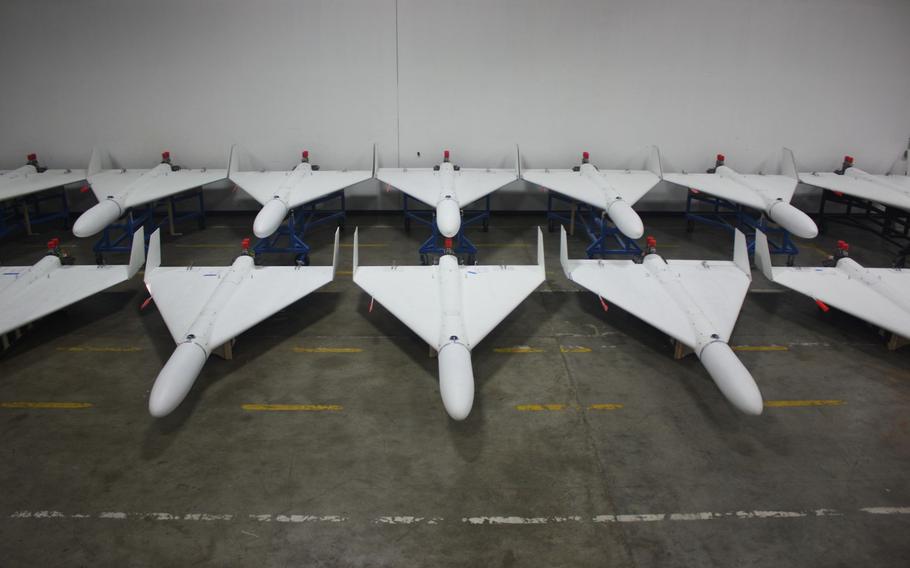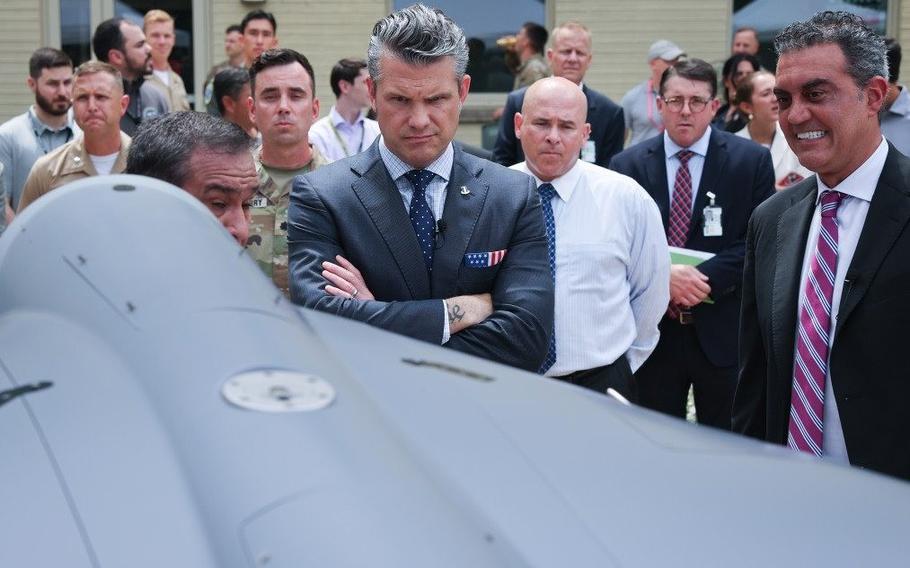
The MQM-172 Arrowhead drone, shown here, is similar to the Iranian Shahed-136, which has caused much damage during the war in Ukraine. The Air Force is asking industry for proposals that would provide up to 36 reverse-engineered replicas of the Shahed-136. (LinkedIn/Daniel Beck/Griffon Aerospace)
The Air Force is on a quest for some drone clones, with a recent solicitation asking industry to replicate an Iranian aircraft that has wreaked havoc in the Russia-Ukraine war and elsewhere.
The service intends to buy at least 16 one-to-one copies of a reverse-engineered Shahed-136, with the option to purchase 20 more later, according to federal documents issued earlier this month.
First appearing in battle six years ago, the inexpensive class of one-way attack drones has become a principal weapon for Iran and its allies.
Sixteen of the drones are not enough to match the firepower of Iran or Russia, which is mass-producing the weapons and at one point was firing 140 Shahed variants into Ukraine every day.
Instead, the U.S. likely wants to use them for testing and training, experts say, underscoring the growing threat from cheap unmanned aircraft.
The drones are estimated to cost between $20,000 and $50,000 apiece, making them cheaper than most long-range attack drones, and have played a key part in Iran’s layered attacks on Israel, where they are often deployed alongside ballistic and cruise missiles.
Last month, Defense Secretary Pete Hegseth reviewed a new model known as the Low-Cost Uncrewed Combat Attack System, or LUCAS, designed by Arizona-based defense contractor SpektreWorks to rival the power of the Shahed-136.

Defense Secretary Pete Hegseth looks at a display of the Low-Cost Uncrewed Combat Attack System, or LUCAS, drone in the courtyard of the Pentagon on July 16, 2025. (Facebook/Army Contracting Command — Rock Island)
The Air Force offered some basic parameters for the Shahed replicas, including dimensions, propulsion system and payload capacity, but it didn’t specify anything about the interior electronics.
That suggests that the focus is more on kinetic deterrence than electronic warfare, said Wolf-Christian Paes, senior fellow for armed conflict at the International Institute for Strategic Studies.
“(The Air Force) basically wants something that flies like a Shahed, looks like a Shahed and arguably has a similar sort of radar signature like a Shahed,” Paes said. “This is about how to potentially shoot it out of the sky if it approaches your position.”
The specified quantity of up to 36 also suggests that the military may be trying to prepare for a mass drone attack, a known weakness of U.S. defense systems, Paes said.
U.S. forces are better-equipped for tracking and shooting down incoming fighter planes or bombers, not the slow, low-flying Shahed drones, which are difficult for radar to pick up, he said.
“That’s something that is hard to train (for) if you don’t have a suitable target drone that flies a similar profile,” Paes said.
The first confirmed use of a Shahed came in 2019, when drone strikes on Saudi oil facilities temporarily disrupted the global oil supply.
Since then, the Iranian drones have been used by Tehran’s allies in Yemen and Iraq, and have been co-opted by Russia under the name Geran-2.
There may be no more famous one-way attack drone in the world today than the Shahed-136, said Behnam Ben Taleblu, the senior director of the Iran Program at the Foundation for Defense of Democracies
It can deliver up to 200 pounds of explosives to predesignated targets at a range of at least 1,200 miles, according to the Open Source Munitions Portal, an online database compiled by munitions experts.
A similar variant, the Shahed-131, has slightly smaller dimensions and can deliver a payload of up to about 45 pounds, according to the database.
The U.S., Israel and Ukraine have been able to defeat large numbers of the drones on the battlefield, but drone deterrence has become a question of both cost and military tactics, Taleblu said.
“Their low price and high volume have shifted the burden of interception into as much a financial equation as a military one, given the cost to track, detect, and most importantly, intercept and destroy these low and slow flying systems,” he said.
The Air Force said in its request for info that the drone replicas will be sent to the Armament Directorate at Eglin Air Force Base in Florida, which designs, develops and fields air-delivered weapons systems.
The service isn’t providing detailed technical designs, which means potential vendors will be required to analyze and develop their own copies of the Shahed-136.